Vegetation
The Vegetation of Springbrook
Vegetation mapping by Queensland Herbarium identifies 24 different Regional Ecosystems on Springbrook. They range from cool temperate, warm temperate and subtropical rainforest to open eucalypt forest and montane heath. Several are considered to be ‘of concern’ regarding their conservation status.
The World Heritage values as described in the nomination include the presence of subtropical, cool temperate and warm temperate rainforest.
Of particular significance among the World Heritage values are “rainforests that are exceptionally rich in primitive and relict species, many of which are similar to fossils from Gondwana”. These species abound in the rainforests of Springbrook.
Also contributing to World Heritage values are the wet sclerophyll forests of which at least two types occur at Springbrook.
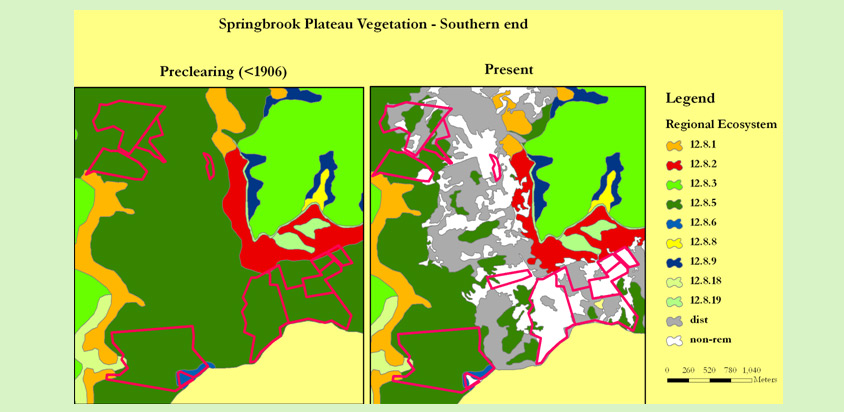
Regional Ecosystem mapping by Queensland Herbarium.
Regional Ecosystems relevant to the restoration project are:
- 12.8.1
- Eucalyptus campanulata tall open forest on Cainozoic igneous rocks
- 12.8.2
- Eucalyptus oreades tall open forest on Cainozoic igneous rocks
- 12.8.3
- Complex notophyll vine forest on Cainozoic igneous rocks. Altitude <600m
- 12.8.5
- Complex notophyll vine forest on Cainozoic igneous rocks. Altitude usually >600m
- 12.8.6
- Simple microphyll fern forest with Nothofagus moorei on Cainozoic igneous rocks
- 12.8.8
- Eucalyptus saligna or E. grandis tall open forest on Cainozoic igneous rocks
- 12.8.9
- Lophostemon confertus open forest on Cainozoic igneous rocks
- 12.8.18
- Simple notophyll vine forest with Ceratopetalum apetalum on Cainozoic igneous rocks
- 12.8.19
- Montane heath on Cainozoic igneous rocks
- dist
- disturbed; much of this is regenerating forest
- non-rem
- non-remnant (mainly cleared land with exotic grass cover)
|
Cool temperate rainforest
These forests are dominated by Antarctic Beech, Nothofagus moorei. The genus Nothofagus illustrates the ancient Gondwanan connections, in that it occurs only in Australasia and South America, former fragments of the Gondwana supercontinent.
Fauna associated with cool temperate rainforest include Masked Mountain Frog Kyarranus loveridgei, Beech Skink Harrisoniascincus zia, Albert’s lyrebird Menura alberti, olive whistler Pachycephala olivacea, Hackeriella veitchi, an ancient lineage of moss bugs (Peloridiidae) occurs in cool temperate rainforest and is associated with mosses, mostly on the trunks of Antarctic Beech.
Flora include the beech orchid Dendrobium falcorostrum, Parsonsia tenuis, Pittosporum oreillyanum, Pararistolochia laheyana, and Dicksonia youngiae.
The orange beech fungus Cyttaria septentionalis is parasitic on beech trees.
|
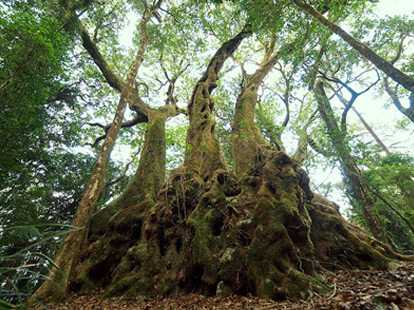 Antarctic Beech, Nothofagus moorei, in cool temperate rainforest.
Antarctic Beech, Nothofagus moorei, in cool temperate rainforest.
© Lui Weber |
At Springbrook, warm temperate rainforest is dominated by Coachwood, Ceratopetalum apetalum. Brush Box, Lophostemon confertus, may also be present.
This forest type provides habitat for a range of rare and threatened plants including the Mountain Birdwing Butterfly Vine, Pararistolochia laheyana. Other threatened flora include rusty rose walnut Endiandra hayesii, small-leaved hazelwood Symplocos baeuerleni.
Albert’s lyrebird Menura alberti inhabits warm as well as cool temperate rainforest.
|
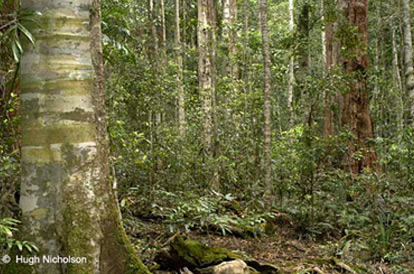 Warm temperate rainforest with Coachwood
Warm temperate rainforest with Coachwood
Photo: Hugh Nicholson |
The World Heritage nomination describes subtropical rainforest as being “rainforests that are exceptionally rich in primitive and relict species, many of which are similar to fossils from Gondwana”. These species abound in the rainforests of Springbrook.
In subtropical rainforest at higher altitudes (cool subtropical rainforest) Black Booyong (Argyrodendron actinophyllum) is generally one of the dominant species whereas at lower altitudes (warm subtropical rainforest) White Booyong (Argyrodendron trifoliolatum) is dominant. At Springbrook, the situation is reversed with White Booyong more common at higher altitudes.
|
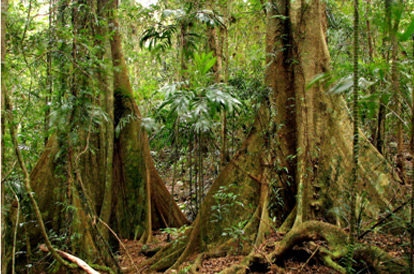 White Booyongs (Argyrodendron trifoliolatum) in subtropical rainforest, Springbrook. Photo: Keith Scott
White Booyongs (Argyrodendron trifoliolatum) in subtropical rainforest, Springbrook. Photo: Keith Scott |
Wet sclerophyll forest
There are at least two types of wet sclerophyll forest at Springbrook. Both have a rainforest understorey and to a significant extent they function ecologically as rainforest. Emergent tall trees are commonly Rose Gum (Eucalyptus grandis), Sydney Blue Gum (Eucalyptus saligna) or Brush Box (Lophostemon confertus). Other species include Tallowwood (Eucalyptus microcorys), White Mahogany (E. acmenoides) and Turpentine (Syncarpia glomulifera subsp. glomulifera).
Wet sclerophyll forest provides habitat for rare and threatened flora species including Lepidozamia peroffskyana.
This forest type also provides very important habitat for numerous fauna species including many that inhabit rainforest. One example is Albert’s Lyrebird which inhabits wet sclerophyll forest where there is a closed canopy and a dense rainforest understorey. |
 Wet sclerophyll forest with eucalypt emergents and rainforest
Wet sclerophyll forest with eucalypt emergents and rainforest
understorey at Springbrook. Photo: Mark Ash |
 Data provided by Queensland Herbarium, Department of Environment and Resource Management
Data provided by Queensland Herbarium, Department of Environment and Resource Management |
|
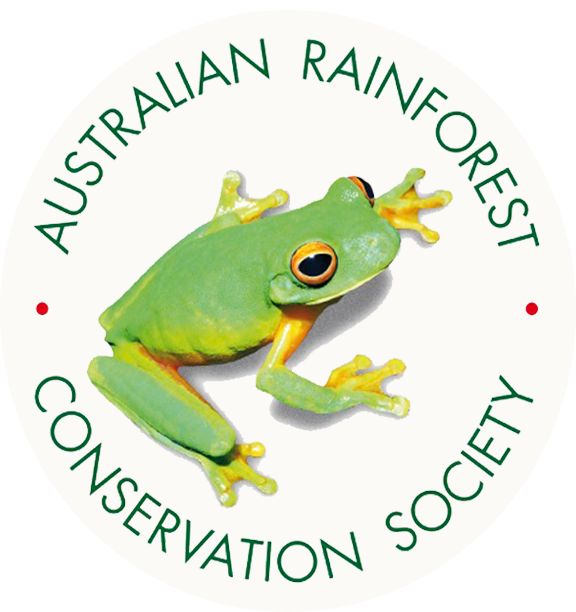 Springbrook Rescue
Springbrook Rescue
 Springbrook Rescue
Springbrook Rescue